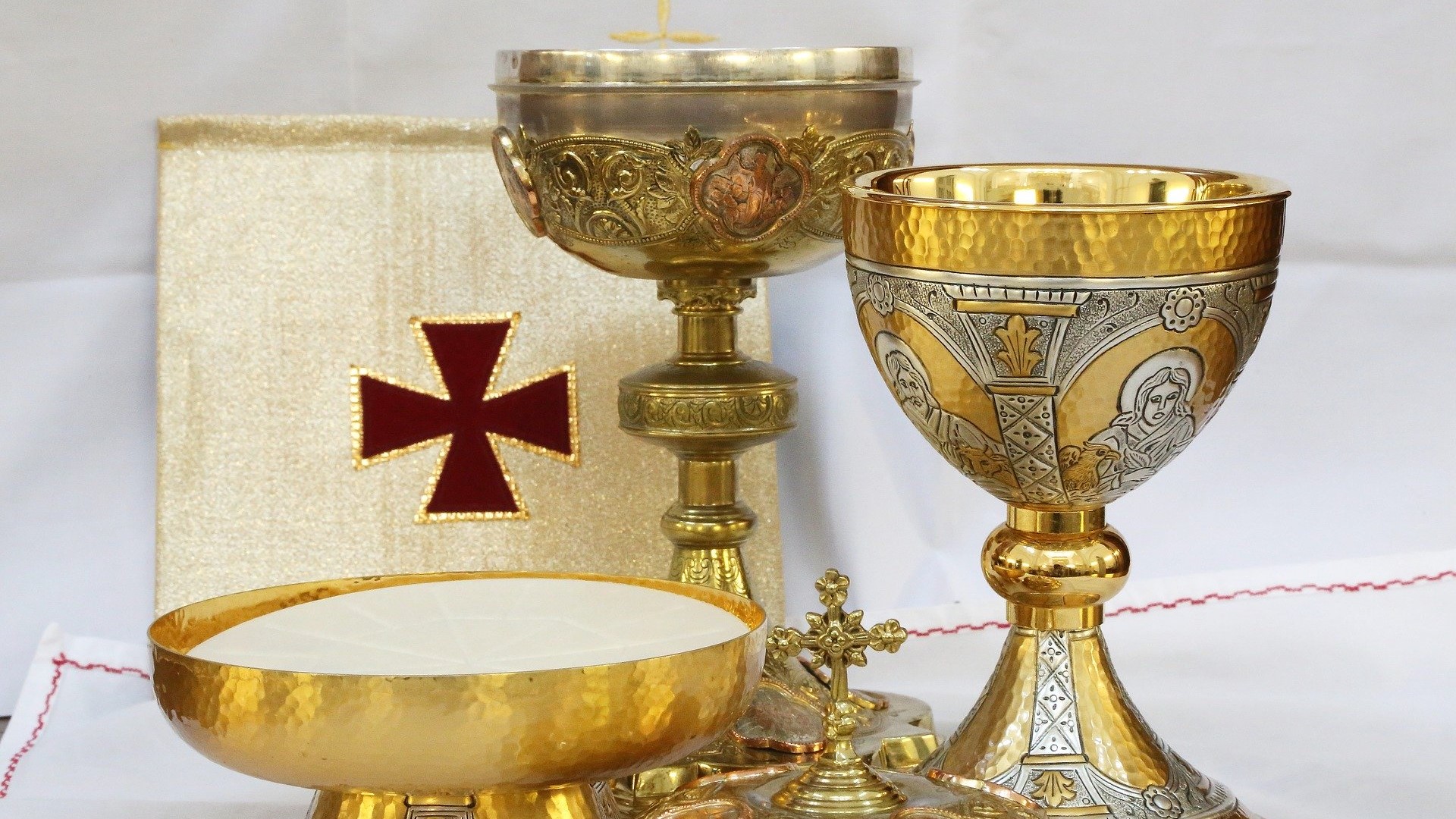Last week I explained that since I’ve been having some fun with Catholic trivia on my episodes of our new summer series,
In All Things, I’ve been thinking about some of the basic things that all Catholics should know about our Faith.
The idea is that I will share with you – off the top of my head, without looking it up – what I know. The point is that if I can know it, so can you.
We began by looking at some basics from Scripture. I hope that you were inspired to open your Bibles and learn more. Did you decide to memorize all the books of the Old Testament in order? I’m still just at 1 and 2 Maccabees (which is way better than I was a month ago)! And, boy am I glad for our Editor, Kristina, who set me straight on a few things (so much for “off the top of my head”).
I can tell you, now, I’ll never forget that Malachi is the last book of the Old Testament!
Today we are going to look at liturgy. I bet that some of you have been going to Mass most of your life. If not, I will guess that you have at least been to Mass a few times. But, how much do you know about liturgy?
Maybe more than you think.
Last week I emphasized that we are a people of the Word. The Word is a huge part of our liturgical life. We are also a sacramental people. Sacraments are also part of our liturgical life.
Perhaps the first question I would ask is this: Do you know what the word
liturgy means?
It comes from the Greek word
leitourgia which means “work for the people”. This is the idea that is behind the work of ministry and also of worship. We use the word
liturgy to include all forms of public worship, so it includes the Mass, but also all the Sacraments and rites. Some devotions such as Eucharistic Adoration also fall under the umbrella of liturgy.
Which leads me to languages:
Which languages (other than the vernacular, that is the language you speak) are used in Catholic liturgy?
Greek, Latin, and Hebrew.
Do you know which prayers of the Mass are commonly recited in those languages? Can you name a few?
Kyrie Eleison: Greek
Alleluia: Hebrew
Sanctus, Agnus Dei: Latin
You will also be familiar with other ones we sometimes say in Latin:
Gloria in excelsis Deo and Pater Noster, to name two.
These are all called “parts of the Mass”. Do you know how many parts of the Mass there are? It’s sort of a trick question because it depends on how you divide it.
I would say that there are two parts:
The Liturgy of the Word and
the Liturgy of the Eucharist.
Some liturgists will say that the
Greeting and the
Concluding Rites fall outside of the Liturgy of the Word and the Liturgy of the Eucharist, so there are four parts. But you can also get specific and, within each of these parts, there are smaller parts.
For example, the
Penitential Rite, the
Readings, and the
Homily happen during the Liturgy of the Word.
The
Eucharistic Prayer and the
Communion Rite happen during the Liturgy of the Eucharist.
Could you name all the specific Mass parts with their proper names? I bet you can name more than you think.
Here’s another basic question:
How many Liturgical Seasons are there, and what are their colours?
Advent (Purple and Rose)
Christmas (White)
Ordinary Time (Green)
Lent (Purple) [Note from the editor: And Rose! For Laetare Sunday - the 4th Sunday of Lent.]
Easter (White)
[Note from the editor: Don't forget that the Triduum (Holy Thursday to Easter Sunday) is its own season.]
There are also days when the liturgical colour is red. Do you know when?
Good Friday, Pentecost, and feasts of martyrs
[Note from the editor: You missed Palm Sunday, Deacon Pedro.]
We tend to say that the priest “says Mass”. Technically, we all “say Mass”. It's a little more accurate to say that the priest “celebrates Mass”. Although, also, technically, all of us celebrate Mass – even though we may say that the priest is the “priest-celebrant”. What’s appropriate is to say that the priest “presides” at Mass. He is the “
presider” or “president” of the celebration. Do you know if there are other priests, what they are called?
Concelebrants. A Mass can only have one presider. All other priests concelebrate the Mass with him.
The deacon serves at Mass.
Do you know what ornaments are used for Mass?
What does the priest wear? What does the deacon wear?
What does a bishop wear? All these articles of clothing are called
vestments.
We have
albs, stoles, chasubles, and dalmatics. Do you know what each one is?
Bishops also wear
zuchettos and
mitres, and archbishops have
pallia. Do you know what those are? Do you know what colour zuchetto (skullcap) a bishop wears? How about a cardinal?
And the staff the bishop uses is called?
Crozier.
Some of the other ornaments that we use at Mass are:
Ciborium: cup that holds the hosts
Paten: small plate that holds the main host
Chalice: cup that holds the wine
Cruet: small container for the wine and water
Pall: cardboard square used to cover the chalice
Corporal: cloth where the hosts and wine are placed for Consecration
Purificators: cloths used to wipe the chalice and purify (clean) the vessels
Do you know the names of the books that are used for Mass?
The
Lectionary has all the readings.
The
Missal is the book with the prayers that the celebrant follows.
Do you know how the readings are chosen for Mass?
There are three cycles of readings: Year A, Year B, and Year C. I won’t get into the nitty-gritty, but what you want to know is that in:
Year A we read from the Gospel of Matthew
Year B from the Gospel of Mark
Year C from the Gospel of Luke
We read the Gospel of John during the Easter Season every year (and on some Sundays during Lent).
Also – if you read my series
Deacon-structing the Acts of the Apostles, you would know that it is also during the Easter season when we read the Acts of the Apostles as a second reading.
It is interesting to me that most Catholics are not really familiar with the concept of daily Mass. I understand why, since I was once in the same boat. Why would I know anything about daily Mass, when I only ever went to Sunday Mass?! I remember once speaking with the Mother Superior of a Carmelite Convent who told me the same thing. When as a teenager she was invited to Mass one weekday, she thought: “What? Catholics have Mass every day?!”
This is why most Catholics are not very familiar with some
Feasts and Solemnities (like the Feast of the Transfiguration from two weeks ago, August 6, or the Feast of the Assumption on August 15).
All we really need to know, I think, is that Sunday is the day of Obligation. We have to go to Mass on Sunday. Other than that, depending on your country, there may be other Holy Days of Obligation. In Canada, it’s just two: The Solemnity of Mary the Mother of God (New Year's Day) and The Solemnity of the Nativity of Our Lord (Christmas). In other countries you may have the Solemnity of the Immaculate Conception or Ascension Thursday, for example. (In Canada, the Solemnity of the Ascension is moved to Sunday – so we are not familiar with the concept of "Ascension Thursday".)
Can you name other Solemnities?
Hint: some are Solemnities of Christ (like Christ the King); others are Marian Solemnities (like Assumption – that’s the question I asked Mikey Needleman in episode 11 of
In All Things, which aired on August 13), and there are four others. (That’s the question I asked Susan Hookong-Taylor in episode 15 of
In All Things, airing August 27.) Can you name any of these?
Let’s look at some other Catholic basics:
The seven Sacraments:
Baptism, Reconciliation, Eucharist, Confirmation, Marriage, Holy Orders, and Anointing of the Sick
I wonder if you know that of these, there are three
Sacraments of Initiation (Baptism, Confirmation, and Eucharist), two
Sacraments of Healing (Anointing of the Sick and Reconciliation), and two
Sacraments of Service (Marriage and Ordination).
Do you know what Anointing of the Sick used to be called?
Extreme Unction. Some will also know it as merely Sacrament of the Sick or confuse it with Last Rites.
Last Rites includes the Anointing, but it also includes all the other rites that are offered to an individual just before death. It may include Penance (Reconciliation), Anointing, and Viaticum (Communion). I think it may include others, like Christian Initiation for the Dying, but that’s not “basics” anymore.
I think we can leave it at that. Let me just say that, other than these basics, I hope that everyone is familiar with other forms of liturgy like the
Liturgy of the Hours or the
Office of the Church (surely you’ve heard of Morning and Evening Prayer?) and also
Eucharistic Adoration. I am always amazed at how many adult Catholics have never been to a Holy Hour or have spent time in Adoration. This is all part of our liturgical life.
I hope that this has piqued your interest in learning more about the Mass and other liturgical practices. If so, you may be interested in reading my
Deacon-structing the Mass series.
It would be impossible to call yourself a Catholic if you do not participate in our liturgical and sacramental life. As Catholics, that is a very big part of what we do: liturgy and ritual. We don’t have to be liturgical experts, but we should know the basics.
I'm sure that thinking about the Mass and all these prayers is making you think of other Catholic devotions, like the Rosary. Let’s address that next week when we look at Catholic basics: Catechism. In the meantime, write to me and tell me how you’re doing with liturgy and what you learned this week.

Every week, Deacon Pedro takes a particular topic apart, not so much to explore or explain the subject to its fullness, but rather to provide insights that will deepen our understanding of the subject. And don’t worry, at the end of the day he always puts the pieces back together. There are no limits to deaconstructing: Write to him and ask any questions about the faith or Church teaching:
[email protected]. Follow him on
Facebook,
Twitter and
Instagram.

 Every week, Deacon Pedro takes a particular topic apart, not so much to explore or explain the subject to its fullness, but rather to provide insights that will deepen our understanding of the subject. And don’t worry, at the end of the day he always puts the pieces back together. There are no limits to deaconstructing: Write to him and ask any questions about the faith or Church teaching: [email protected]. Follow him on Facebook, Twitter and Instagram.
Every week, Deacon Pedro takes a particular topic apart, not so much to explore or explain the subject to its fullness, but rather to provide insights that will deepen our understanding of the subject. And don’t worry, at the end of the day he always puts the pieces back together. There are no limits to deaconstructing: Write to him and ask any questions about the faith or Church teaching: [email protected]. Follow him on Facebook, Twitter and Instagram.